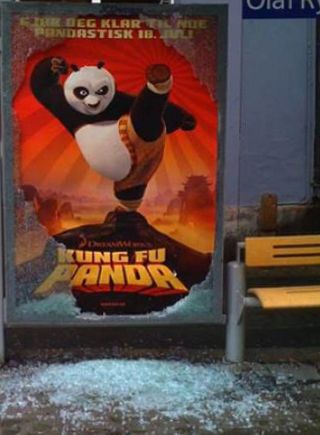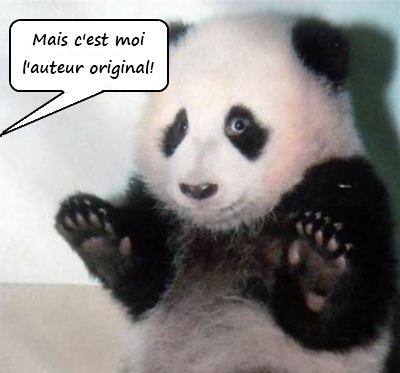Panda algorithm, facts and myths
Changes to the algorithm on April 11, 2011 surprised webmasters and sparked many theories that Google actually wants to fine.

Last level reached
Facts
Google wants to remove low-content pages from the visible part of the index
Low content refers to texts and images that actually have few independent feedbacks.
The site as a whole is penalized if part of the pages is considered poor content
This was officially confirmed. Punishment can be light or large depending on the proportion of pages with low content. Thus, pages that led in results can lose several positions and appear behind links on pages of less interest, or that are next to a question because the site is fined.
Criminalization is almost irreversible
It does not affect the pages, but assigns a negative score to the site as a whole, which depends on the number of backlinks. A fined site is less likely to get a BL, unable to regain traffic.
To cancel it, you need to add new pages to rich content to improve the site's rating, as well as improve pages with poor content and that do not have backlinks. Objectively "poor," which makes the site pandalize. (see Panda algorithm article).
Different things when the site duplicates content, as this causes a different fine.

Poor quality window
Google knows it's unfairly fining sites
Google advises: "merge surface pages to make more useful content." Spam does not combine to create useful content, the council speaks well to conscientious webmasters.
Panda has one goal - to fight spam. To prevent spammers from moving forward due to trial and error, sanctions are imposed on the entire site that prevent them from knowing which side is the target and do not cancel the fine when removing content considered poor.
By fining an entire site for some of the content, it is known that high-quality content can also be fined.
The site can be fined when copying its content
A side effect is that sites whose content is often copied have been achieved by this change, as Google often cannot tell the difference between what the original is and what the copy is.
Typically, the algorithm should punish sites that receive content from other sites. But it often happens that the original and copy are confused, and the first is mistaken for the second.
This even happened with popular sites such as cultofmac.com.
The site may be fined for a previous case
The site may have lost a significant portion of its traffic during the Panda Update for a reason unrelated to content quality, which was confirmed by Matt Cutts.
The site has already received a negative signal, for example, for posting links to a link farm and received a negative score without affecting its traffic. The effect occurs on April 11, when this score is combined with other unfavorable criteria .
Panda is not a change in algorithm, but another program
This is a program that runs at regular intervals and views sites at a different level, trying first of all to determine the usefulness of pages, their interest in the user.
But recently Google (at SMX in June 2014) announced that it uses more than 500 algorithms to position pages, so the concept of a general algorithm loses its meaning.
Google files two patents in connection with Panda
Patent 8.190.537, published on October 31, 2008, describes how, based on the characteristics of a number of pages, it is possible to recognize these characteristics on other pages, classify them with the previous ones. That's what Panda does. Finding the characteristics of sites without useful content on a new site, we can conclude that it does not have useful content.
Thus, if a site's pages are similar to those of sites without useful content, it will be fined even if it offers useful content.
It goes without saying that if all the pages of the site are made according to the same template, then it has a better chance of getting under Panda .
Patent 8,682,962, filed on March 25, 2014 by the same algo Panda initiation engineer, describes how a total score is set for a group of resources that changes the score of the main algorithm.
Panda reduced spam, but did not improve results
Panda did remove some of the spam, only some, because we always see the first results occupied by commercial pages that are not necessarily consistent with what we are looking for. For example, requesting "free software" often results in "paid software with a free trial."
As a rule, results do not improve, and it is always difficult to find what you are looking for when it does not come down to a few keywords.
Many smaller sites have been punished when they offer unique content. This was partially fixed with the May 20, 2014 update.
Myths
Myth: Panda assesses the quality of a site by its content
This myth was deliberately supported by Google communicators: Panda is an algorithm that fines pages with insufficient content or no interest. This implies that the engine analyzes pages to evaluate their content, which is completely untrue.
In fact, Panda compares the number of completely independent links to site pages with the number of requests that these pages show, and determines the ratio. The smaller the ratio, the more the site is fined. This is described in patent 8682892.
It is a fact that the method favors sites that have more genuine backlinks and need original and interesting content to get them. But this indirect effect also depends on other factors. Through advertising activities, you can get many links to banal content. It's more popularity than quality that counts.
Myth: It was a group of Google employees who determined the quality of the site
The Panda algorithm will analyze the site based on criteria determined by a group of employees who were presented with a set of sites and who decided which ones were of high quality and which were not. Sites are then penalized for deviating from this predetermined norm regardless of other criteria. This study did identify a formula that establishes a vague correlation between score and quality, but nothing in the algo is aimed at analyzing page quality.
Myth: Site punished for running too many ads
The number of ads per page is not taken into account by the search engine algorithm. By the way, the Google Adsense service allows you to display 6 units on one page.
Google will never fine a site for running too many ads... Matt Cutts confirmed during PabCon 2011 that advertising is not a direct criterion for Panda.
The page is penalized for having too little content (possibly one sentence) along with nearly exclusive promotional stuffing. There is a difference between 3 ads that cover 90% of the page area and 3 ads that cover 10% of its area.
Myth: Panda is made against content farms
Several requirements were combined in this new algorithm. Perhaps the firm is annoyed by the arrogance of companies like Demand Media, too often seen on the media (and no longer heard of from Panda), and the joke of a yacht called Adsense, but the update has a more general and long-term purpose.
It affected 14% of English-language sites, meaning millions of sites.
Containment trusses were most likely used as sampling, as several variants of the "Panda" were produced until they were all cast.
The future of search engines is not compatible with pages without original content. Google can be expected to either reduce its information sources or not replace them .
Myth: Gmail account could wreak havoc on site
If you publish a newsletter through Gmail and a significant number of subscribers do not open messages when they arrive, or make a spam report, the site issuing the newsletter receives a fine, the webmaster says lockergnome.com.
It has removed subscriptions and successfully made a review request.
But this is formally denied by Matt Cutts: the petition for review is not limited to what the webmaster says, she can cancel an unspecified fine.

Cut Of Mac pandalized because its site was copied gets whitelisted entry